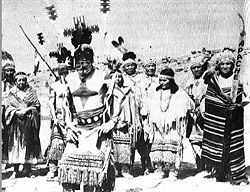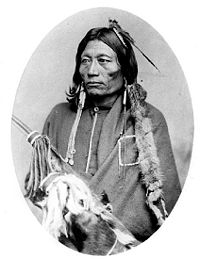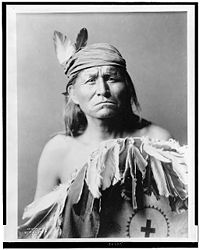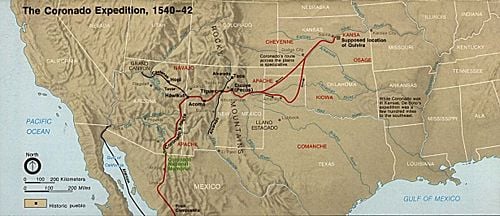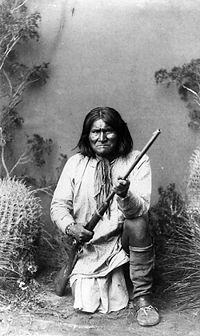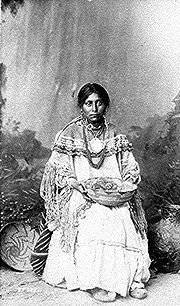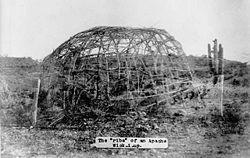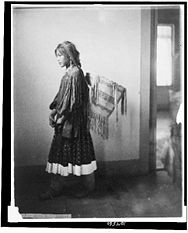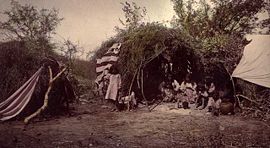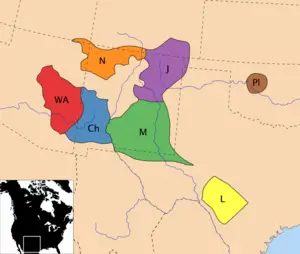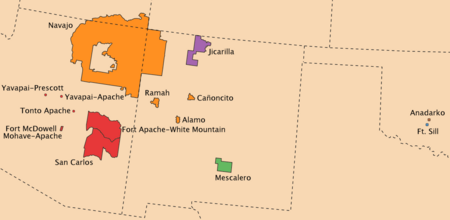Apache
| Apache | |
|---|---|
| Total population | 31,000+ |
| Regions with significant populations | Arizona, New Mexico and Oklahoma |
| Language | Chiricahua, Jicarilla, Lipan, Plains Apache, Mescalero, Western Apache |
| Religion | Shamanism, Christianity |
Apache is the collective name for several culturally related groups of Native Americans in the United States. They speak a Southern Athabaskan (Apachean) language, and are related linguistically to the Athabaskan speakers of Alaska and western Canada, and migrated to the Southwestern United States around 1000 C.E. The modern term "Apache" excludes the related Navajo people. However, the Navajo and the other Apache groups are clearly related through culture and language and thus together are considered Apachean. Apachean peoples formerly ranged over eastern Arizona, northwestern Mexico, New Mexico, and parts of Texas and the Great Plains.
The Apache featured significantly in the history of the Southwestern states during the latter part of the nineteenth century. Apache groups were initially involved in trade relationships with the Spanish and European settlers and attempted to maintain peace with them through several treaties. However, their incessant raiding, which they considered an acceptable treatment of neighbors and non-hostile, coupled with numerous misunderstandings and betrayals led to the Apache Wars. With skillful and determined leaders such as Cochise, Mangas Coloradas, Victorio, and Geronimo, the Apache resisted domination by the Europeans for over two decades. Refusing to be confined to reservations, they attempted to maintain their traditional nomadic lifestyles, practicing their religious rituals, and maintaining their freedom.
Apache groups now live in Oklahoma and Texas and on reservations in Arizona and New Mexico. Although their languages are endangered and their lifestyle is very different from the past, many aspects of Apache culture have been retained, as has part of their ancestral lands. Despite their history of strife and misunderstanding, contemporary Apache seek to maintain and revitalize their ancestors' wisdom and ways, while adopting aspects of other cultures that they find of value, just as their ancestors did in their time.
Name
The word Apache entered English via Spanish, but the ultimate origin is uncertain. The most widely accepted origin theory suggests it was borrowed from the Zuni word apachu meaning "enemy" or the Yuma word for "fighting-men."[1] The Apache native name has several versions including N'de, Inde, or Tinde ("the people").[2]
Apache groups (excluding the Navajo) include Western Apache, Chiricahua, Mescalero, Jicarilla, Lipan, and Plains Apache (formerly known as Kiowa-Apache).
Language
The Apache and Navajo tribal groups speak related languages of the language family referred to as Athabaskan, suggesting that they were once a single ethnic group, linguistically called "Apachean." Southern Athabascan (or Apachean) is sub-family of the larger Athabascan family, which is a branch of Nadene.
All Apachean languages are endangered including Navajo, which is notable for being the indigenous language of the United States with the largest number of native speakers. Lipan is reported extinct.
History
The Apache homeland is in the Southwest of the United States, an area that spreads across much of New Mexico and Arizona, as well as west Texas, south Colorado, western Oklahoma, south Kansas, and into northern Mexico.[2] Other Athabaskan-speaking people in North America reside in an area from Alaska through west-central Canada, and some groups can be found along the Northwest Pacific Coast.
Entry into the Southwest
Archaeological and historical evidence suggest the Southern Athabaskan entry into the American Southwest sometime after 1000 C.E. Their nomadic way of life complicates accurate dating, primarily because they constructed less-substantial dwellings than other Southwestern groups.[3] They also left behind a more austere set of tools and material goods. Other Athabaskan speakers adapted many of their neighbors' technology and practices in their own cultures, suggesting the Apache probably did the same.
There are several hypotheses concerning Apachean migrations. One posits that they moved into the Southwest from the Great Plains. In the early sixteenth century, these mobile groups lived in tents, hunted bison and other game, and used dogs to pull travois loaded with their possessions. Substantial numbers of these people were recorded over a wide range by the Spanish.
Spanish explorer Francisco Coronado observed Plains people ("dog nomads") in 1541:
After seventeen days of travel, I came upon a rancheria of the Indians who follow these cattle (bison). These natives are called Querechos. They do not cultivate the land, but eat raw meat and drink the blood of the cattle they kill. They dress in the skins of the cattle, with which all the people in this land clothe themselves, and they have very well-constructed tents, made with tanned and greased cowhides, in which they live and which they take along as they follow the cattle. They have dogs which they load to carry their tents, poles, and belongings.[4]
The Spaniards described the Plains dogs as very white, with black spots, and ânot much larger than water spaniels.â Such dogs are capable of pulling loads up to 50 lb (20 kg) on long trips, at rates as high as two or three miles per hour (three to five km/h).[5]
Another theory posits migration south, through the Rocky Mountains, ultimately reaching the Southwest. Only the Plains Apache have any significant Plains cultural influence, while all tribes have distinct Athabaskan characteristics. Their presence on both the Plains and in the mountainous Southwest indicate that there were multiple early migration routes.
When the Spanish arrived in the area, trade between the Pueblo peoples and the Southern Athabaskans was well established. They reported the Pueblos exchanged maize and woven cotton goods for bison meat, hides, and materials for stone tools. Coronado observed Plains people wintering near the Pueblos in established camps.
Conflict with Mexico and the United States
Spanish sovereignty over the area disrupted trade between the Pueblos and the diverging Apache and Navajo groups. The Apache quickly acquired horses, improving their mobility for quick raids on settlements. In addition, the Pueblo were forced to work Spanish mission lands and care for mission flocks, thus they had fewer surplus goods to trade with their neighbors.[3]
In general, there developed a pattern between the Spanish who settled in villages and Apache bands. Both raided and traded with each other. Records of the period seem to indicate that relationships depended upon the specific villages and specific bands that were involved with each other. For example, one band might be friends with one village and raid another. When war happened between the two, the Spanish would send troops, after a battle both sides would "sign a treaty" and both sides would go home.
These traditional and sometimes treacherous relationships continued between the villages and bands with the independence of Mexico in 1821. By 1835, Mexico had placed a bounty on Apache scalps but some bands were still trading with certain villages. When Juan JosĂŠ Compas, the leader of the MimbreĂąo Apaches, was killed for bounty money in 1837, Mangas Coloradas or Dasoda-hae (Red Sleeves) became principal chief and war leader and began a series of retaliatory raids against the Mexicans.
When the United States went to war against Mexico, many Apache bands promised U.S. soldiers safe passage through their lands. In 1846, when the U.S. claimed former territories of Mexico, Mangas Coloradas signed a peace treaty, respecting them as conquerors of the Mexican's land. An uneasy peace between the Apache and the citizens of the United States held until the 1850s, when an influx of gold miners into the Santa Rita Mountains led to conflict. This period is known as the Apache Wars.
Apache leaders like Mangas Coloradas of the Bedonkohe, Cochise of the Chokonen (also known as Chiricahua), Victorio of the Chihenne band, Juh of the Nednhi band, Delshay of the Tonto, and Geronimo of the Bedonkohe led groups of resistance against the military's attempts to relocate their people to various reservations.
The United States' concept of a reservation had not been used by the Spanish, Mexicans, or other Apache neighbors before. Reservations were often badly managed, and bands that had no kinship relationships were forced to live together. There were also no fences to keep people in or out. It was not uncommon for a band to be given permission to leave for a short period of time. Other times a band would leave without permission, to raid, return to their land to forage, or to simply get away. The military usually had forts nearby. Their job was keeping the various bands on the reservations by finding and returning those who left.
For over two decades, Apache groups eluded both U.S. and Mexican armies, and by 1886, thousands of troops were in pursuit, including the legendary scout Kit Carson. It is a somber story of treachery and misunderstanding. Cochise is famous for his skills as a warrior, and as the leader of an uprising that began in 1861, in reaction to false accusation, imprisonment, and execution of several Chiricahua. However, due to his willingness to embrace U.S. Army scout Tom Jeffords, a white man and former enemy, Cochise was able to negotiate a treaty that allowed his people to remain on part of their ancestral lands and their culture survived. For others, though, the violence continued. Famously, Geronimo led a group of warriors in resistance for many years until their final surrender in 1886. At that time, the last resisting Apaches were sent to Florida, and then to Alabama where many succumbed to malaria, tuberculosis, and malnutrition, and finally in 1894, to Fort Sill, Oklahoma, remaining prisoners of war until 1913. Geronimo was among those who died without being able to return to the homeland.
Culture
The warfare between Apachean peoples and Euro-Americans has led to a stereotypical focus on certain aspects of Apachean cultures that are often distorted through misperception:
Of the hundreds of peoples that lived and flourished in native North America, few have been so consistently misrepresented as the Apacheans of Arizona and New Mexico. Glorified by novelists, sensationalized by historians, and distorted beyond credulity by commercial film makers, the popular image of "the Apache"âa brutish, terrifying semihuman bent upon wanton death and destructionâis almost entirely a product of irresponsible caricature and exaggeration. Indeed, there can be little doubt that the Apache has been transformed from a native American into an American legend, the fanciful and fallacious creation of a non-Indian citizenry whose inability to recognize the massive treachery of ethnic and cultural stereotypes has been matched only by its willingness to sustain and inflate them.[6]
The Apache tribes were indeed historically powerful, constantly at enmity with the Spaniards and Mexicans for centuries. The U.S. Army, in their various confrontations, found them to be fierce warriors and skillful strategists.[7] In reality, though, many of their attacks were raids, considered a normal complement to trade, and not warfare. The Apache also had a well-developed social structure, religion, and lifestyle, albeit markedly different from the Europeans with whom they clashed violently.
Social organization
All Apachean peoples lived in extended family units that usually lived close together with each nuclear family in a separate dwelling. An extended family generally consisted of a husband and wife, their unmarried children, their married daughters, their married daughters' husbands, and their married daughters' children. Thus, the extended family is connected through a lineage of women that live together (that is, matrilocal residence), into which men may enter upon marriage (leaving behind his parents' family). When a daughter was married, a new dwelling was built nearby for her and her husband. Among the Western Apache, who usually practiced matrilocal residence, sometimes the eldest son chose to bring his wife to live with his parents after marriage. All tribes practiced sororate (in which a man married his wife's sister, usually after the wife is dead or has proven infertile) and levirate marriages (in which a woman marries one of her husband's brothers after her husband's death, if there were no children, in order to continue the line of the dead husband).
All Apachean men practiced varying degrees of "avoidance" of his wife's close relativesâoften strictest between mother-in-law and son-in-law. The degree of avoidance varied between different Apachean groups. The most elaborate system was among the Chiricahua, where men used indirect polite speech toward and were not allowed to be within visual sight of relatives with whom they were in an avoidance relationship. Female Chiricahua relatives also did likewise to them.
Several extended families worked together as a "local group" which carried out certain ceremonies and economic and military activities. Political control was mostly present at the local group level. Local groups were headed by a chief, a man who had considerable influence over others in the group due to his effectiveness and reputation. The chief was the closest societal role to a leader in Apachean cultures. The office was not hereditary and often filled by members of different extended families. The chief's leadership was only as strong as he was evaluated to beâno group member was ever obliged to follow the chief. The Western Apache criteria for evaluating a good chief included: Industriousness, generosity, impartiality, forbearance, conscientiousness, and eloquence in language.
Many Apachean peoples joined together several local groups into bands. Band organization was strongest among the Chiricahua and Western Apache, while in the Lipan and Mescalero it was weak.
On the larger level, the Western Apache organized bands into "groups."[8] Goodwin reported five groups for the Western Apache: Northern Tonto, Southern Tonto, Cibecue, San Carlos, and White Mountain. The Jicarilla grouped their bands into "moieties" perhaps influenced by northeastern Pueblos. Additionally the Western Apache and Navajo had a system of matrilineal clans that were organized further into "phratries" (perhaps influenced by western Pueblos).
The notion of "tribe" in Apachean cultures is very weakly developed, essentially being only a recognition "that one owed a modicum of hospitality to those of the same speech, dress, and customs."[9] The various Apachean tribes had no political unity and often were enemies of each otherâfor example, the Lipan fought against the Mescalero just as with the Comanche.
The Apache groups adopted lifeways from other tribes with whom they came into contact. For example, Western Apache took up farming after the Pueblo peoples; the Plains Apache lived close to the Kiowa adopting a similar culture to them (hence they were often called the Kiowa-Apache). The Jicarilla Apache adopted many traits from the Plains Indians, having acquired horses from the Spanish they often rode in pursuit of the great buffalo herds.[2]
Kinship systems
The Apachean tribes have two surprisingly different kinship systems: a "Chiricahua type" and a "Jicarilla type."[10] The Chiricahua type system is used by the Chiricahua, Mescalero, and Western Apache, with the Western Apache differing slightly from the other two systems and having some shared similarities with the Navajo system. The Jicarilla type, which is similar to the Dakota-Iroquois kinship systems, is used by the Jicarilla, Lipan, and Plains Apache.
- Chiricahua
The Chiricahua kinship is bilateral and organized in generational terms. Sororate marriage, levirate marriage, and sororal polygyny was practiced. Except for parent-child terms, all terms are self-reciprocal. Parental siblings are distinguished by side but otherwise are classified together without regard for gender and with terms extended to their children. Grandparent terms are extended to their siblings. Thus, one's maternal grandmother, one's maternal grandmother's sisters, and one's maternal grandmother's brothers are all identified with the same term. However, different terms are used for each of maternal grandfather, paternal grandmother, and paternal grandfather. Due to reciprocity, a grandparent will use the same term to refer to their grandchild as the grandchild uses to refer to their grandparent.[10]
Chiricahua cousins are not distinguished from siblings through kinship terms. Thus, the same word will refer to either a sibling or a cousin (there are not separate terms for parallel-cousin and cross-cousin). Male relationship with a female sibling is restrained, yet very caring towards her offspring. In-law avoidance is common.[11]
- Jicarilla
Unlike the Chiricahua system, Jicarilla kinship ties were reckoned bilaterally, with terminology following the Iroquoian system. The Jicarilla have different terms according to gender, but without division according to maternal and paternal lineage. Also, terms are not reciprocal.
The father and the father's brother were classed under a single term, as were the mother and the mother's sister. Parallel-cousins were grouped with siblings and cross-cousins were classed separately. No terminological distinction was made between maternal and paternal grandparents nor between male and female grandchildren.[12]
Housing
All people in the Apache tribe lived in one of three types of houses. The first of which is the teepee, used by those who lived in the plains. The wickiup, an eight-foot tall frame of wood held together with yucca fibers and covered in brush, was used by Apache groups in the highlands. If a family member lived in a wickiup and they died, the wickiup would be burned. The final housing is the hogan, an earthen structure in the desert area that was good for keeping cool in the hot weather of northern Mexico.
Below is a description of Chiricahua wickiups recorded by anthropologist Morris Opler:
The home in which the family lives is made by the women and is ordinarily a circular, dome-shaped brush dwelling, with the floor at ground level. It is seven feet high at the center and approximately eight feet in diameter. To build it, long fresh poles of oak or willow are driven into the ground or placed in holes made with a digging stick. These poles, which form the framework, are arranged at one-foot intervals and are bound together at the top with yucca-leaf strands. Over them a thatching of bundles of big bluestem grass or bear grass is tied, shingle style, with yucca strings. A smoke hole opens above a central fireplace. A hide, suspended at the entrance, is fixed on a cross-beam so that it may be swung forward or backward. The doorway may face in any direction. For waterproofing, pieces of hide are thrown over the outer hatching, and in rainy weather, if a fire is not needed, even the smoke hole is covered. In warm, dry weather much of the outer roofing is stripped off. It takes approximately three days to erect a sturdy dwelling of this type. These houses are âwarm and comfortable, even though there is a big snow.â The interior is lined with brush and grass beds over which robes are spread.[13]
The women were responsible for the construction and maintenance of the wickiup.
Food
Apachean peoples obtained food from four main sources:
- Hunting wild animals
- Gathering wild plants
- Growing domesticated plants
- Interaction with neighboring peoples for livestock and agricultural products (through raiding or trading)[9]
As the different Apache tribes lived in different environments, the particular types of foods eaten varied according to their respective environment. For example, the Western Apache diet consisted of 35-40 percent meat and 60-65 percent plant foods.[14]
Hunting
Hunting was done primarily by men, although there were sometimes exceptions depending on animal and culture. For instance, Lipan women could help in hunting rabbits and Chiricahua boys were also allowed to hunt rabbits.
Hunting often had elaborate preparations, such as fasting and religious rituals performed by medicine men (shamans) before and after the hunt. In Lipan culture, since deer were protected by Mountain Spirits, great care was taken in Mountain Spirit rituals in order to ensure smooth deer hunting. Also the slaughter of animals was performed following certain religious guidelines from prescribing how to cut the animals, what prayers to recite, and proper disposal of bones. A common practice among Apache hunters was the distribution of successfully slaughtered game. For example, among the Mescalero a hunter was expected to share as much as one half of his kill with a fellow hunter and with needy persons back at the camp. Feelings of individuals concerning this practice spoke of social obligation and spontaneous generosity.
The most common hunting weapon before the introduction of European guns was the bow and arrow. Various hunting strategies were used. Some techniques involved using animal head masks worn as a disguise. Whistles were sometimes used to lure animals closer. Another technique was the relay method where hunters positioned at various points would chase the prey in turns in order to tire the animal. A similar method involved chasing the prey down a steep cliff.
Eating certain animals was taboo. Although different cultures had different taboos, some common examples of taboo animals included: bears, peccaries, turkeys, fish, snakes, insects, owls, and coyotes. An example of taboo differences: the black bear was a part of the Lipan diet (although not as common as buffalo, deer, or antelope), but the Jicarilla never ate bear because it was considered an evil animal. Some taboos were a regional phenomena, such as of eating fish, which was taboo throughout the southwest (e.g. in certain Pueblo cultures like the Hopi and Zuni) and considered to be snake-like (an evil animal) in physical appearance.[15]
Plants
The gathering of plants and other foodstuffs was primarily a female chore. However, in certain activities, such as the gathering of heavy agave crowns, men helped. Numerous plants were used for medicine and religious ceremonies in addition their nutritional usage. Some plants were utilized for only their religious or medicinal value.
The abundant agave (mescal) was used by all Apache, but was particularly important to the Mescalero. The name Mescalero is, in fact, derived from the word mescal, a reference to their use of this plant as food. They gathered the crowns in late spring after reddish flower stalks appeared. The smaller sotol crowns were also important. The crowns (the tuberous base portion) of this plant (which were baked in large underground ovens and sun-dried) and also the shoots were used. The baked and dried agave crowns were then pounded into pulp and formed into rectangular cakes.
The different Apache groups varied greatly with respect to growing domesticated plants. The Western Apache, Jicarilla, and Lipan practiced some crop cultivation. The Mescalero and one Chiricahua band practiced very little cultivation. The other two Chiricahua bands and the Plains Apache did not grow any crops.
Trading and raiding
Although not distinguished by Europeans or Euro-Americans, all Apache tribes made clear distinctions between raiding (for profit) and war. Raiding was done with small parties with a specific economic target. Warfare was waged with large parties (often using clan members) with the sole purpose of retribution.
Religion
Most Apache âgodsâ or diyĂâ are personified natural forces that run through the universe and are used for human purposes through ritual ceremonies:
The term diyĂâ refers to one or all of a set of abstract and invisible forces which are said to derive from certain classes of animals, plants, minerals, meteorological phenomena, and mythological figures within the Western Apache universe. Any of the various powers may be acquired by man and, if properly handled, used for a variety of purposes.[6]
Apache religious stories relate two culture heros (one of the sun/fire, Killer-Of-Enemies/Monster Slayer, and one of water/moon/thunder, Child-Of-The-Water/Born For Water) that destroy a number of creatures that are harmful to humankind. Another story is of a hidden ball game where good and evil animals decide whether or not the world should be forever dark. Coyote, the trickster, is an important being that usually has inappropriate behavior (such as marrying his own daughter). The Western Apache, Jicarilla, and Lipan have creation myths while this is lacking in the Chiricahua and Mescalero.[9]
Different Apachean cultures had different views of ceremonial practice. Most Chiricahua and Mescalero ceremonies were learned by personal religious visions while the Jicarilla and Western Apache used standardized rituals as the more central ceremonial practice. These ceremonies were led by medicine men (shamans). Important standardized ceremonies include the puberty ceremony (sunrise dance) of young women, Jicarilla long-life ceremonies, and Plains Apache sacred-bundle ceremonies.
Many Apache ceremonies use masked representations of religious spirits. Sandpainting is important to the Western Apache, and Jicarilla. Both the use of masks and sandpainting are believed to be a product of cultural diffusion from neighboring Pueblo cultures.[9]
The Apache also participate in many spiritual dances including the rain dance, a harvest and crop dance, and a spirit dance. These dances were mostly for enriching their food resources.
Art
The Apache originally wore deerskin clothing, neither growing cotton nor raising sheep for wool. They prepared elaborate costumes for religious ceremonies, impersonating spirits, wearing headdresses, masks, and body paint for the ritual dances. The headdresses were of four colors symbolizing the four Gans (mountain spirits): white of pollen, black of eagle feathers, yellow of deerskin, and blue of turquoise.[2]
Apache were master basketmakers, crafting coiled baskets with intricate designs.[2]
The Apache became famous for their "Apache fiddle." Their name Tzii'edo' a 'tl means "wood that sings." The painted sound box was made from a hollowed agave stalk with sinew attached to a tuning peg. It was played with a bow of wood and sinew. As it is the only Native American bowed instrument, it remains unclear whether it is indigenous or of European derivation.[16]
Contemporary Apache
Twenty-first century Apache groups include the Jicarilla and Mescalero of New Mexico, the Chiricahua of the Arizona-New Mexico border area, the Western Apache of Arizona, the Lipan Apache of southwestern Texas, and the Plains Apache of Oklahoma. A number of Apache are also dispersed around the country in large cities.
Western Apaches are the only Apache group that remains within Arizona. The group is divided into several reservations that crosscut cultural divisions. The Western Apache reservations include the Fort Apache White Mountain, San Carlos, Yavapai-Apache, Tonto-Apache, and Fort McDowell Mohave-Apache reservations. There are also Apaches on the Yavapai-Prescott reservation and off-reservation in Arizona and throughout the United States. The White Mountain Apache Tribe is located in the east central region of Arizona, 194 miles (312Â km) northeast of Phoenix. The Tonto Apache Reservation was created in 1972 near Payson in eastern Arizona. The tribe operates a casino. The Yavapai-Apache Nation Reservation southwest of Flagstaff, Arizona, is shared with the Yavapai. There is a visitor center in Camp Verde, Arizona, and at the end of February an Exodus Days celebration is held with a historic re-enactment and a pow-wow.
The Mescalero are located on the Mescalero Reservation in southeastern New Mexico, near historic Fort Stanton.
The Chiricahua were divided into two groups after they were released from being prisoners of war. The majority moved to the Mescalero Reservation and are now subsumed under the larger Mescalero political group. The other Chiricahuas remained in Oklahoma and eventually formed the Fort Sill Apache Tribe of Oklahoma.
The Lipan, now few in number, are located primarily on the Mescalero Reservation. Other Lipans live in Texas.
The Jicarilla are located on the Jicarilla Reservation in Rio Arriba and Sandoval counties in northwestern New Mexico.
Plains Apaches are located in Oklahoma, concentrated around Anadarko.
Notes
- â Indians.org, Inde (Apache) Literature. Retrieved July 23, 2008.
- â 2.0 2.1 2.2 2.3 2.4 Carl Waldman, Encyclopedia of Native American Tribes (New York: Checkmark Books, 2006, ISBN 978-0816062744).
- â 3.0 3.1 Linda S. Cordell, Ancient Pueblo Peoples (St. Remy Press and Smithsonian Institution, 1994, ISBN 0895990385).
- â George P. Hammond and Agapito Rey (eds.), Narratives of the Coronado Expedition 1540-1542 (Albuquerque, NM: University of New Mexico Press, 1977, ISBN 0404146694).
- â Richard Henderson, "Replicating Dog Travois Travel on the Northern Plains." Plains Anthropologist 39 (1994): 145-59.
- â 6.0 6.1 Keith H. Basso, Western Apache witchcraft (Anthropological papers) (Tucson, AZ: University of Arizona Press, 1969, ISBN 0816501424).
- â Emma and Todd Uzzelly, Apache Indians Defended Homelands in Southwest Borderlands. Retrieved July 24, 2008.
- â Grenville Goodwin, The Social Organization of the Western Apache (Tucson, AZ: University of Arizona Press, 1969, ISBN 0816501947).
- â 9.0 9.1 9.2 9.3 Alfonso Ortiz and William C. Sturtevant (eds.), Handbook of North American Indians, Volume 10, Southwest (Washington, DC: Smithsonian Institution, 1983).
- â 10.0 10.1 Morris E. Opler, "The kinship systems of the Southern Athapaskan-speaking tribes" American Anthropologist, 38(4) (1936): 620-633.
- â James Q. Jacobs, Post-Contact Social Organization of Three Apache Tribes (1999). Retrieved July 23, 2008.
- â World Culture Encyclopedia, Jicarilla Kinship. Retrieved July 24, 2008.
- â Morris E. Opler, An Apache Life-way: The Economic, Social, and Religious Institutions of the Chiricahua Indians (Kessinger Publishing, 2008, ISBN 978-1436702508) 22-23, 385-386.
- â Raymond DeMallie and William Sturtevant (eds.), Handbook of North American Indians Volume 13: Plains (Washington, DC: Smithsonian Institution, 2001, ISBN 0160504007).
- â David M. Brugge, Navajos in the Catholic Church Records of New Mexico 1694-1875 (Navajo Community College Press, 1986. ISBN 0912586591), 494.
- â Metropolitan Museum of Art, Tzii'edo' a 'tl (Apache Fiddle). Retrieved July 23, 2008.
ReferencesISBN links support NWE through referral fees
- Basso, Keith H. Western Apache witchcraft (Anthropological papers). Tucson, AZ: University of Arizona Press, 1969. ISBN 0816501424.
- Brugge, David M. Navajos in the Catholic Church Records of New Mexico 1694-1875. Navajo Community College Press, 1986. ISBN 0912586591.
- Cordell, Linda S. Ancient Pueblo Peoples. St. Remy Press and Smithsonian Institution, 1994. ISBN 0895990385.
- DeMallie, Raymond, and William Sturtevant (eds.). Handbook of North American Indians Volume 13: Plains. Washington, DC: Smithsonian Institution, 2001. ISBN 0160504007.
- Etulain, Richard W. New Mexican Lives: A Biographical History. Albuquerque, NM: University of New Mexico Press, 2002. ISBN 0826324339.
- Goodwin, Grenville. The Social Organization of the Western Apache. Tucson, AZ: University of Arizona Press, 1969 (original 1941). ISBN 0816501947.
- Haley, James L. Apaches: A History and Culture Portrait. University of Oklahoma Press, 1997. ISBN 0806129786.
- Hammond, George P., and Agapito Rey (eds.). Narratives of the Coronado Expedition 1540-1542. Albuquerque, NM: University of New Mexico Press, 1977. ISBN 0404146694.
- Henderson, Richard. "Replicating Dog Travois Travel on the Northern Plains." Plains Anthropologist 39 (1994): 145-59.
- Jacobs, James Q. Post-Contact Social Organization of Three Apache Tribes, 1999. Retrieved July 23, 2008.
- Opler, Morris E. The kinship systems of the Southern Athapaskan-speaking tribes. American Anthropologist 38(4) (1936): 620-633.
- Opler, Morris E. An Apache Life-Way: The Economic, Social, and Religious Institutions of the Chiricahua Indians. Kessinger Publishing, 2008 (original 1941). ISBN 978-1436702508.
- Ortiz, Alfonso and William C. Sturtevant (eds.). Handbook of North American Indians, Volume 10, Southwest. Washington, DC: Smithsonian Institution, 1983. ISBN 0160045797.
- Roberts, David. Once They Moved Like The Wind: Cochise, Geronimo, And The Apache Wars. Touchstone, 1994. ISBN 0671885561.
- Sweeney, Edwin R. Mangas Coloradas: Chief of the Chiricahua Apaches. University of Oklahoma Press, 1998. ISBN 0-8061-3063-6.
- Terrell, John Upton. Apache chronicle. World Publishing, 1972. ISBN 0529045206.
- Waldman, Carl. Encyclopedia of Native American Tribes. New York: Checkmark Books, 2006. ISBN 978-0816062744.
External links
All links retrieved August 11, 2023.
- San Carlos Apache Tribe (Arizona Intertribal Council)
- Tonto Apache Tribe (Arizona Intertribal Council)
- White Mountain Apache Tribe (Arizona Intertribal Council)
- Yavapai-Apache Nation (Arizona Intertribal Council)
- White Mountain Apache Tribe
- Official Yavapai-Apache Nation website
- Post-Contact Social Organization of Three Apache Tribes
- Inde (Apache) Literature
| ||||||||
Credits
New World Encyclopedia writers and editors rewrote and completed the Wikipedia article in accordance with New World Encyclopedia standards. This article abides by terms of the Creative Commons CC-by-sa 3.0 License (CC-by-sa), which may be used and disseminated with proper attribution. Credit is due under the terms of this license that can reference both the New World Encyclopedia contributors and the selfless volunteer contributors of the Wikimedia Foundation. To cite this article click here for a list of acceptable citing formats.The history of earlier contributions by wikipedians is accessible to researchers here:
The history of this article since it was imported to New World Encyclopedia:
Note: Some restrictions may apply to use of individual images which are separately licensed.
